Ken Lizzi's Blog, page 2
July 27, 2025
Back Home
I spent the last two weeks revisiting family and old friends in the Portland area. It was at times relaxing and at others hectic. But overall I enjoyed it. Now I’m back home. While it feels good to return, I’m still facing much of the work deriving from the recent move. Such is life: a seemingly endless stream of petty annoyances in pursuit of peace. Beats the alternative, though. I’m grousing, not complaining, if you see the difference.
Writing time was intermittent. It is hard to maintain a routine while on the road. Some days the word count suffered, some days allowed extra time. On balance I don’t think I fell too far behind, reaching 65,000 words on the WIP. A book is taking shape.
Speaking of books, there is less than a week remaining to back the Cirsova Kickstarter for Cesar the Bravo. While the project has funded, the number hasn’t yet been achieved for interior illustrations. So, if you haven’t already backed it, yet want an entertaining work of Sword-and-Sorcery, please do so while time remains. Operators are not standing by.
Now, if you will excuse me, I have a busy Sunday. (And Monday, and — well, you get the picture.)
July 20, 2025
Michael Resnick’s “Pursuit on Ganymede.”
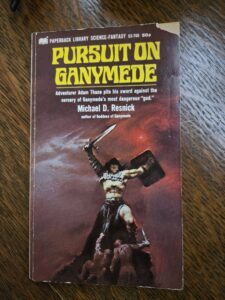
Once upon a time, Powell’s Books in Portland used to be a trove of used paperback treasures at prices a hungry college student could afford. Now when I happen to visit PDX (to see old friends, family, visit clients, etc.) I still stop in to browse. Gone are the days of bargain prices. But still in the spinner rack labeled (if I recall correctly) “buy it for the cover” you can find somewhat discounted books. It was from that rack that I picked up Michael D. Resnick‘s Pursuit on Ganymede.
I soon discovered that this was book two, a sequel to The Goddess of Ganymede (which I may, or may not, get a copy of in the future.) Pursuit, it becomes immediately apparent, is an homage to Edgar Rice Burroughs’ John Carter of Mars books, complete with the opening chapter explaining that the following narrative is being told to another writer who is providing it for publication to us, the readers. The hero, who ended up on Ganymede on a spaceship in the course of events which I no doubt will learn if I ever get the first book, is a prototypical Sword-and-Planet protagonist by the name of Adam Thane. On the lower gravity world of Ganymede (Jupiter’s largest moon) he possesses the leaping ability and greater strength in the tradition of John Carter. This serves him well in the course of the extended pursuit of the villains (survivors, it seems, of the first book) who have abducted his fiancee.
The (short) book is episodic, consisting of very short chapters which fall into a pattern of travel, fighting monsters, capture or entrapment, escape, more fighting, etc. Monster fights are swapped out now and then for battles with Ganymede’s inhabitants, humans with (again in the Barsoom tradition) different skin colors. Most of the standard notes are hit: Adam is enslaved, fights in a gladiatorial arena, is befriended by nobility, is unquestioningly placed at the head of military forces during battles, overcomes psychic assaults by sheer willpower, etc. You get pretty much what you expect, no more and no less.
The love of the source material is unveiled. While Pursuit isn’t a classic, there is a certain pleasure to be found in its earnestness and purity. This is early Resnick, with a publication date of 1968. He went on to a fine, prolific career. This won’t be the first of his books to placed on my shelves.
I’m hoping you will be placing my next book on your shelves. Specifically Cesar the Bravo, which, as of this writing, is about $200 shy of funding on the publisher’s Kickstarter. Almost there and with plenty of time left. But I for one would like to see an illustrated edition. That means stretch goals. So if you haven’t already backed the project, I ask you to consider doing so. Illustrators need to eat too.
July 13, 2025
ERB’s “The Lost Continent” and the Great War.

The Lost Continent (original title Beyond Thirty) is a short, pared-down action novel by Edgar Rice Burroughs first published in 1916, only four years after ERB’s breakout work, Tarzan. 1916 was, of course, smack in the middle of World War I, and the influence is clear.
The story takes place in the 22nd century. Pan-America is the sole power through both the northern and southern American continents in the aftermath of a tremendous war in Europe in the 20th century. And Pan-America is deliberately and utterly isolated, by law and tradition forbidden to cross the 30th meridian to the east and 175th to the west. A powerful navy patrols the seas and enforces the borders. The narrator and hero of the story, Lt. Jefferson Turck, is a young naval commander. His combination flying ship/submarine, is forced through a combination of mechanical failure, storm, and sabotage, to break the convention and cross the 30th. He is then abandoned (along with three companions) in a boat which he navigates to England and subsequently the continent, encountering tribes reduced to primitive savagery and preyed upon by tigers, lions, and wolves. A romance with a barbarian woman (apparently a direct descendant of the British monarchy) largely drives what plot there is while Turck gleans some of what occurred during the devastating war, its aftermath, and what transpires in the rest of the world beyond Pan-America’s self-imposed borders.
It is a quick, entertaining read, if not particularly inspired in plot. (ERB employed much the same basic plot, though not setting, in other tales; e.g. The Land of Hidden Men.) What intrigued me the most was the suggestions the book provided into ERB’s depth of concerns regarding the Great War. The descriptions of the remnants of Europe are apocalyptic, bombs having utterly leveled most cities. There are references to gas attacks. ERB seemed genuinely worried that the war might nearly depopulate England and, perhaps, much of Europe. He might also have been commenting on America’s isolationism, though whether he favored intervention or preferred the US to remain uninvolved I could not ascertain from the story.
The Lost Continent remains one of ERB’s more obscure works. But I for one was glad it did not remain lost to me.
Now, if you will indulge me, I would like to direct your attention to the Cirsova Kickstarter for my next book. It is (as of this writing) close to funding. But it isn’t there yet. Please back the project and help push it over the top. I’m proud of this one and hope to share it with as many readers as possible. I think you’ll like it. I thank you — and I am sure the publisher would thank you — for your patronage.
July 6, 2025
En Garde! “Cesar the Bravo” is En Route.

It has been about fifteen years in the making. As I recall, it was in 2010 that I began writing the first Cesar the Bravo story, longhand, in a notebook on a flight to Hawaii, finishing it up pool side. A rough life, I know. That story ended up in an anthology in 2011. The next couple of stories appeared a few years later. And the exploits of Cesar continued.
Who is Cesar and why should you be interested? An excellent question, you insightful and discriminating reader. Cesar (“Chay-zar”, but pronounce it however you want — you’re an adult) lives by his wits and his sword in the city of Plenum, a fantastical analog of renaissance Rome. He is a bravo, a paid duelist, a soldier-for-hire. Whatever pays his cheap rent, expensive tailor bills, and the tab at Giacomo’s wine bar. He was not born with an ideal swordsman’s physique. Instead he’s of middle height (almost), and built like a wrestler rather than a fencer. But Cesar refuses to let that shortcoming hold him back. He has a gift for the work, a superior fencing master (when Cesar can afford to pay the man), tenacity, a dedicated sense of professionalism, and the toughness that comes from growing up in the gutters of Plenum.
Plenum. A city ruled by the Collegium, the organization of magi gifted with the ability to summon and control the beings colloquially known as demons. The variety, usefulness, and intelligence levels of demons is vast. And not all magi possess the skill and ability to summon the more powerful demons. But those with the ability to summon demons necessarily rule over those who lack it.
Cesar certainly lacks that ability. And yet he constantly runs into situations pitting him against demons. It’s enough to make a man drink And it is hard on the wardrobe.
The collected adventures of Cesar the Bravo have been compiled by Cirsova, which is currently running a Kickstarter campaign. As of this writing, the campaign is over halfway to the minimum goal. But I for one would like to see accompanying illustrations. So, please back the project and let’s get some interior artwork. En garde!
June 29, 2025
The Web Log Has Migrated
After three years in Houston, MBW, the HA, and I have packed our bags. Forgive this short post. I’ve been up since 4AM. I drove to the new Web Log Headquarters in San Antonio, and have been unloading, unpacking, driving about town for various essential purchases, and generally sweating my fundament off all day.
I do hope to have an announcement next week, for which I should have the leisure to write a proper post. In the meantime, let me again flog my latest for your reading pleasure: I contributed a story to Cirsova Magazine’s Summer 2025 issue. Get yours now for a fix of sword-swinging heroic fantasy.
June 22, 2025
Poisoned Lands: Stormlands Book Three.
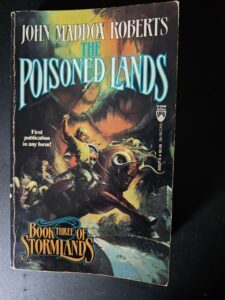
Several years pass between the end of the second book of John Maddox Roberts’ Stormlands, The Black Shields, and the third book, The Poisoned Lands. Enough years for the sons of the series’ hero, Hael, to have reached a warrior’s age. Hael, in fact, makes no appearance in this volume, apparently busy in the East acquiring firearms. His eldest son, Ansa, takes on the primary role as protagonist, being about the same age as Hael when he left the Stormlands in book one.
Joining Ansa as protagonist is Fyana, a blue-skinned mystic of the Canyonlands (presumably the Grand Canyon.) She also serves as love interest. Ansa and Fyana are fine young heroes. Through their eyes (as well as through the eyes of the villain and villainess) we readers are introduced to new lands south of the Kol (Colorado, presumably) River. As usual, Roberts’ travel guide is colorful, exotic, and entertaining. And, as usual, he keeps the adventure moving. There are a couple of excellent battle scenes, some small-scale skirmishes, and plenty of drama and intrigue. The final chapter moves even faster, resolving in the last few pages the serious trouble Ansa managed to get himself into. And, as expected, the foundation is laid for the conflict in the next book. I hope that will involve Hael. While Ansa was fun to follow, I’m curious to catch up with the mature Hael and get an insight into his doings and schemes.
Notions of age, aging, and mortality are crucial to the plot. I appreciated the examination from various viewpoints. Why? Because it was well done, of course. Not due to my own…increasing maturity and venerable status. No. I’m in my prime.
In case you haven’t gathered this fact before, I’m thoroughly enjoying this series. How I’ve let it slip past unnoticed all these years is a mystery. But I’m glad I get to read it now.
If you’re looking for something to read (while waiting for your copies of the Stormlands books to arrive, I suppose) allow me to flog my latest. Cirsova Magazine Issue #23 is now available, and I have contributed a story.
June 15, 2025
Andrew Offutt’s “My Lord Barbarian.”
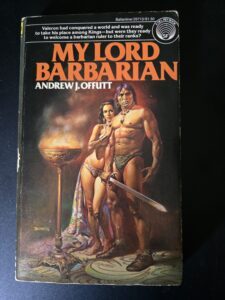
My Lord Barbarian is a slim planetary romance by Andrew Offutt. It begins with an intriguing premise and a reasonable pretext to include spaceships and sci-fi technology in a story of sword-swinging barbarians. (Again I’m reminded why Gary Gygax enshrined Offutt in Appendix N.) The pulp action picks up rather quickly after the introductory chapter and carries the story along at a rapid pace through the first couple of acts. The third act took me somewhat by surprise. I expected a ramping up of action, perhaps a violent set-piece battle. Instead, however, the hero’s triumph took place with little opposition or dramatic threat (with the exception of a return to form just prior to the denouement.) Offutt decided to go with a romantic dilemma, political intrigue, and a philosophic inquiry into the nature of barbarism rather than straight-forward action. It worked just fine and I enjoyed the tale. It simply wasn’t what I’d expected, especially given that Boris Vallejo cover, and it seemed to me that Offutt could have done more with the premise, almost as if he’d rushed through this one, rather than exploring the worlds and characters he’d created. I’d perhaps have liked this to be stretched into a series, pushing off the final conquest and overthrow of the villain until book three or four. (Perhaps I’m getting spoiled by John Maddox Roberts’ Stormlands series.) Sometimes it reads as more setup than payoff. Still, if you are looking for a breezy, 70s-era work of heroic science-fantasy, you could do worse than My Lord Barbarian. It will entertain you, presuming you aren’t one of the easily offended readers uncomfortable with anything written prior to, oh, say 2017. But if you’ve been reading this web log for more than an entry or two you’re unlikely to fall into the killjoy category. So, pick up a copy and kick back for a few hours.
Now to move on to today’s shameless plug, which will be longer than usual. I’ve got a couple of items to flog today.
First, allow me note that the Summer 2025 issue of Cirsova Magazine hits June 18, with a story by yours truly. Get one while it’s still hot off the press.
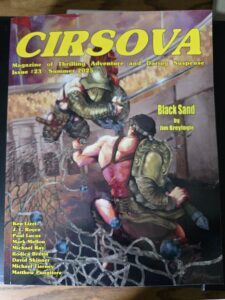
Second, if you click this link, you will see the news regarding my next book, Cesar the Bravo. (Pronounced, at least by the author, as Chay-zar.) This particular form of publishing is still new to me and I’m intrigued to follow the process. I’ve been writing Cesar’s exploits since 2012 and I’m happy to see him get greater exposure. I’ve got an advance proof copy. It’s a hefty chunk of book, with plenty of reading matter between the covers. I think you’re going to like it, so please get on the band wagon early.
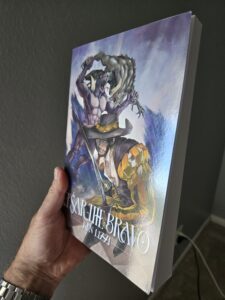
June 8, 2025
NTRPG 2025
Home at last. After the trip to Florida I had a half-day at home before heading north to Dallas for the North Texas RPG Con. I have put a few miles on the car over the last week or so.
The con was, as usual, both fun and exhausting. I played in a few games, met some people, was reacquainted with several others, and hung out with friends. As a bit of a change up, I played in a miniatures war game, Ty Beard’s A Fistful of TOWS refereed by the man himself. I will not be dominating the war games circuit anytime soon. Or ever. But it was entertaining.
I don’t have time for any longer after action report. Instead I’m getting a head start on the week’s worth of work I need to catch up with in about a day, in addition to the usual Sunday chores.
But before I sign off, here’s the obligatory crass marketing: Buy my books, please.
June 1, 2025
The Black Shields. And a Vacation.
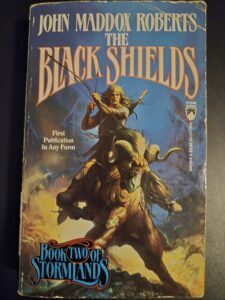
Maybe it is wider margins. Or maybe it is just sheer readability. For whatever reason, I’m surging through John Maddox Roberts’ Stormlands books at nearly the same pace I used to read as a kid. The first book, The Islander, was engaging and moved right along. The second, The Black Shields, shows no let up.
While the first was rather episodic, providing set-up and travelogue, world-building and character introduction, the second book has a more focused narrative, suggesting the direction of the rest of the series: a showdown, military, political, and personal, between the main character and his nemesis. We get such a showdown in this book, but, as with any series villain worth his salt, the bad guy escaped to fight another day.
The world-building continues, offering the reader glimpses into a handful of other post-apocalyptic cultures. A plot seed or two gets planted for future volumes. And our hero’s Hun/Parthian cavalry tactics are put to a practical test in the field. The centerpiece might be the detailed, engrossing, and bloody depiction of an attempted sea-borne assault on a fortified city. Even knowing how it was likely to end (for narrative purposes it had to go that way) it nonetheless gripped me.
Good stuff.
Vacation is also good. I drove MBW and the HA to Pensacola, Florida. I’m writing this post from an apartment overlooking a marina, perhaps a trifle the worse for yesterday’s poolside indulgences. The HA has had a marvelous time, playing in the sea, swimming with a “mermaid” in lazy river, ziplining, climbing, and racing go-karts. I particularly enjoyed the visit to Fort Pickens. I believe this qualifies as my first trip to a Civil War battle site.
On the publishing front, the next book is nearing release. The publisher emailed me mockups of the covers of the paperback and hardcover editions. Looking good. I hope to share more later.
If you are interested in reading anything of mine currently available, browse here.
And now, here are a few vacation pictures.






May 25, 2025
Sherwood. In the Ten Ring.
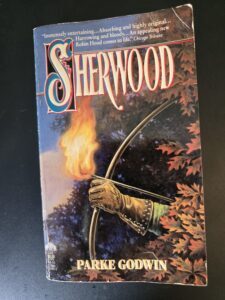
In the mid-Eighties I added a couple of Parke Godwin novels to my shelf, Firelord and the Last Rainbow. I recall being impressed by the stories and the literary style. So when I happened across a copy of Mr. Godwin’s Sherwood for $.99 I did not hesitate to purchase it. It seemed good value for 529 pages.
As the title (not to mention that cover art) indicate, this is a retelling of the Robin Hood legend. Godwin does something interesting with it, setting it over a century back from the usual King Richard the Lionheart crusader era. In placing the story primarily in the years following the Battle of Hastings, Godwin reinforces Robin’s character as a freedom fighter, rather than as a romantic bandit figure, having him serve as a focus of Saxon resistance to the Norman invader. It works quite well. Many of the traditional cast of characters show up, though generally in unexpected fashion and with different story arcs and fates. Don’t expect Howard Pyle with the serial number filed off.
To some extent, this is a work of mainstream historical fiction. Though most of the players are legendary or invented, William the Conqueror and his queen, Matilda, are major characters. There are hints of fantasy: the Second Sight and a sort of blood and soil marriage ceremony between Robin and Marian. But these are contextualized as cultural beliefs and never manifest as concrete reality within the narrative. There are also some excellent action sequences, well-drawn battles, skirmishes, and personal combat. This is not, however, a work of Heroic Fiction, instead, as I indicated, in the main a historical novel. So great care is lavished on period detail and the characterization is deep. Therein lies some of both the book’s strengths and weaknesses. Each character is given his due in full. The villains are not mustache-twirlers, instead described as cultural exemplars, acting according to what is perceived as right and proper. Internal viewpoints are given full expression. This all works beautifully for a historical novel, but for those wanting to get on to Robin’s next act of derring-do, some scenes might drag on. I suppose your appreciation will depend upon what you are in the mood for.
The last act came as rather a pleasant surprise; expertly, if deviously, built toward and perfectly realized, fitting in with the characters as established and realistically transformed. Moreover, it fit within the larger theme Godwin was developing of the forced interaction between two societies: the Saxon individuality and deep reliance upon belief in ancient rights and duties contrasting with the Norman hierarchical culture and feudal view that every man must have a master else life is meaningless. Robin’s decisions are unexpected, and yet are shown as reasonable and foresighted. Or, you can just ignore the thematic context and go along for the bloody battle scenes. Either works.
If you’d like some more bloody battle scenes, pick up my Falchion’sCompany trilogy, available in print, digital, and audio formats.



